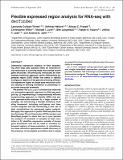Flexible expressed region analysis for RNA-seq with derfinder

View/
Author
Collado-Torres, Leonardo
Nellore, Abhinav
Frazee, Alyssa C.
Wilks, Christopher
Love, Michael I.
Langmead, Ben
Leek, Jeffrey T.
Jaffe, Andrew E.
Published Version
https://doi.org/10.1093/nar/gkw852Metadata
Show full item recordCitation
Collado-Torres, Leonardo, Abhinav Nellore, Alyssa C. Frazee, Christopher Wilks, Michael I. Love, Ben Langmead, Rafael A. Irizarry, Jeffrey T. Leek, and Andrew E. Jaffe. 2017. “Flexible expressed region analysis for RNA-seq with derfinder.” Nucleic Acids Research 45 (2): e9. doi:10.1093/nar/gkw852. http://dx.doi.org/10.1093/nar/gkw852.Abstract
Differential expression analysis of RNA sequencing (RNA-seq) data typically relies on reconstructing transcripts or counting reads that overlap known gene structures. We previously introduced an intermediate statistical approach called differentially expressed region (DER) finder that seeks to identify contiguous regions of the genome showing differential expression signal at single base resolution without relying on existing annotation or potentially inaccurate transcript assembly. We present the derfinder software that improves our annotation-agnostic approach to RNA-seq analysis by: (i) implementing a computationally efficient bump-hunting approach to identify DERs that permits genome-scale analyses in a large number of samples, (ii) introducing a flexible statistical modeling framework, including multi-group and time-course analyses and (iii) introducing a new set of data visualizations for expressed region analysis. We apply this approach to public RNA-seq data from the Genotype-Tissue Expression (GTEx) project and BrainSpan project to show that derfinder permits the analysis of hundreds of samples at base resolution in R, identifies expression outside of known gene boundaries and can be used to visualize expressed regions at base-resolution. In simulations, our base resolution approaches enable discovery in the presence of incomplete annotation and is nearly as powerful as feature-level methods when the annotation is complete. derfinder analysis using expressed region-level and single base-level approaches provides a compromise between full transcript reconstruction and feature-level analysis. The package is available from Bioconductor at www.bioconductor.org/packages/derfinder.Other Sources
http://www.ncbi.nlm.nih.gov/pmc/articles/PMC5314792/pdf/Terms of Use
This article is made available under the terms and conditions applicable to Other Posted Material, as set forth at http://nrs.harvard.edu/urn-3:HUL.InstRepos:dash.current.terms-of-use#LAACitable link to this page
http://nrs.harvard.edu/urn-3:HUL.InstRepos:31731874
Collections
- FAS Scholarly Articles [18292]
- SPH Scholarly Articles [6362]
Contact administrator regarding this item (to report mistakes or request changes)


